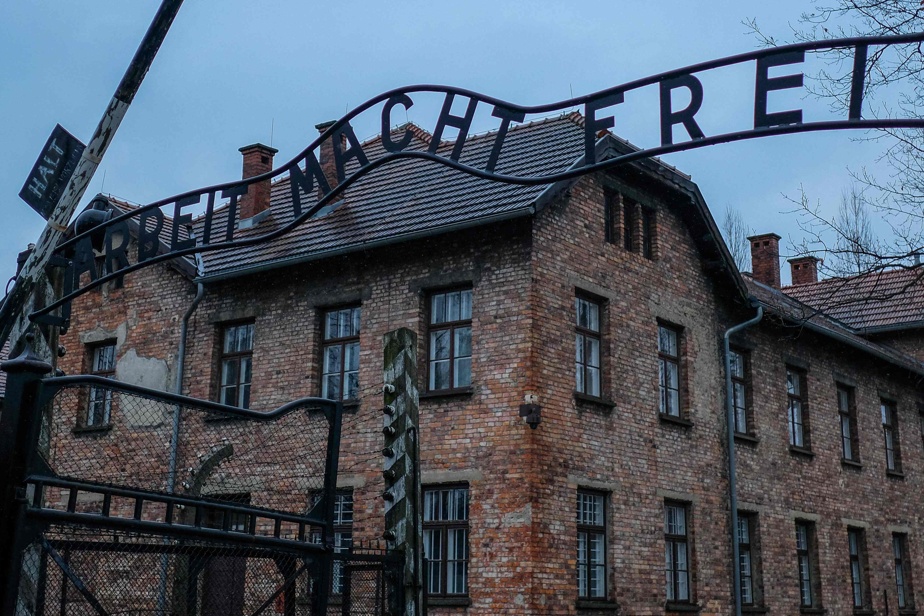(Auschwitz) A group of survivors of the Nazi extermination camps marked the 79e anniversary of the liberation of the Auschwitz-Birkenau camp during World War II, during a modest ceremony Saturday in southern Poland.
Around 20 survivors from various camps established by Nazi Germany across Europe laid wreaths and flowers at the Death Wall at Auschwitz and lit candles.
Later, the group will pray near the Birkenau monument. The survivors will pay tribute to an estimated 1.1 million victims of the camps, most of whom were Jews. The memorial site and museum are located near the town of Oswiecim.
Nearly six million European Jews were killed by the Nazis during the Holocaust — the massacre of Jews and other groups before and during World War II.

PHOTO CZAREK SOKOLOWSKI, ASSOCIATED PRESS
Holocaust survivors and relatives visited the Auschwitz-Birkenau camp on Saturday to commemorate the 79e anniversary of his release.
On the occasion of the International Day dedicated to the memory of the victims of the Shoah, the survivors will be accompanied by the President of the Polish Senate Malgorzata Kidawa-Blonska, the Minister of Culture Bartlomiej Sienkiewicz and the Israeli Ambassador to Poland Yacov Livne .
The theme of the celebrations is the human being, symbolized by simple hand-drawn portraits. These sketches are intended to emphasize that the horror of Auschwitz-Birkenau lies in the suffering of the people detained and killed there.
The victims of the Shoah have been commemorated throughout Europe.
In Germany, where people laid flowers and lit candles at memorials to victims of Nazi terror, Chancellor Olaf Scholz maintained that his country would continue to bear responsibility for this “crime against humanity.”
He called on all citizens to defend German democracy and fight anti-Semitism, as the country commemorated the liberation of Auschwitz.

PHOTO NADJA WOHLLEBEN, REUTERS ARCHIVES
German Chancellor Olaf Scholz
“’Never again’ is every day,” Olaf Scholz said in his weekly podcast. January 27 calls to us: stay visible! Stay audible! Against anti-Semitism, against racism, against misanthropy — and for our democracy. »
Ukrainian President Volodymyr Zelensky, whose country is struggling to repel Russia’s full-scale invasion, posted an image of a Jewish menorah on X, formerly Twitter, to mark the day of commemoration.
“Each new generation must learn the truth about the Holocaust. Human life must remain the highest value for all nations in the world,” said Volodymyr Zelenskyy, who is Jewish and lost loved ones in the Holocaust.
“Eternal memory to all the victims of the Holocaust! “, Mr. Zelensky wrote on X.
In Italy, Holocaust commemorations included a torchlight procession accompanied by official statements from senior political leaders.

PHOTO REMO CASILLI, REUTERS ARCHIVES
Italian Prime Minister Giorgia Meloni
Italian Prime Minister Giorgia Meloni maintained that her conservative nationalist government was determined to stamp out anti-Semitism which she said had been “reinvigorated” due to the conflict between Israel and Hamas.
M’s detractorsme Meloni has long accused him and his Brotherhood of Italy party, with its neofascist roots, of failing to sufficiently atone for their past.
Later Saturday, left-wing movements planned a torchlight procession to commemorate all the victims of Nazism — Jews, but also Roma, homosexuals and political dissidents deported or exterminated in Nazi camps.
Police were also on alert after pro-Palestinian activists indicated they would ignore a police order and hold a rally planned to coincide with Holocaust commemorations. Italy’s Jewish community complains that such protests have become opportunities for the memory of the Holocaust to be co-opted by anti-Israeli forces and used against Jews.
In Poland, a memorial ceremony with prayers took place on Friday in Warsaw, at the foot of the monument to the ghetto heroes who fell fighting the Nazis in 1943.
Earlier this week, the countries of the former Yugoslavia signed an agreement in Paris to jointly renovate block 17 of the red brick Auschwitz camp and install a permanent exhibition there in memory of around 20,000 people deported and brought to the camp. Bosnia and Herzegovina, Croatia, Montenegro, North Macedonia, Serbia and Slovenia will participate in the project.
Preserving the camp, a notorious symbol of the horrors of the Holocaust, with its cruelly misleading “Arbeit Macht Frei” (“Work sets you free”) gate, requires constant efforts by historians and experts, as well as substantial funds.
The Nazis, who occupied Poland from 1939 to 1945, first used the former Austrian military barracks at Auschwitz as a concentration and death camp for Polish resistance fighters. In 1942, the wooden barracks, gas chambers and crematoria of Birkenau were added for the extermination of Jews, Roma and other European nationals, as well as Russian prisoners of war.
Soviet Red Army troops liberated Auschwitz-Birkenau on January 27, 1945, where there were about 7,000 prisoners, children and people who were too weak to walk. A few days earlier, the Germans had evacuated tens of thousands of other detainees on foot in what is now known as the death march, as many detainees died of exhaustion and cold in freezing temperatures.
Since 1979, the Auschwitz-Birkenau site has been included on the UNESCO World Heritage List.
